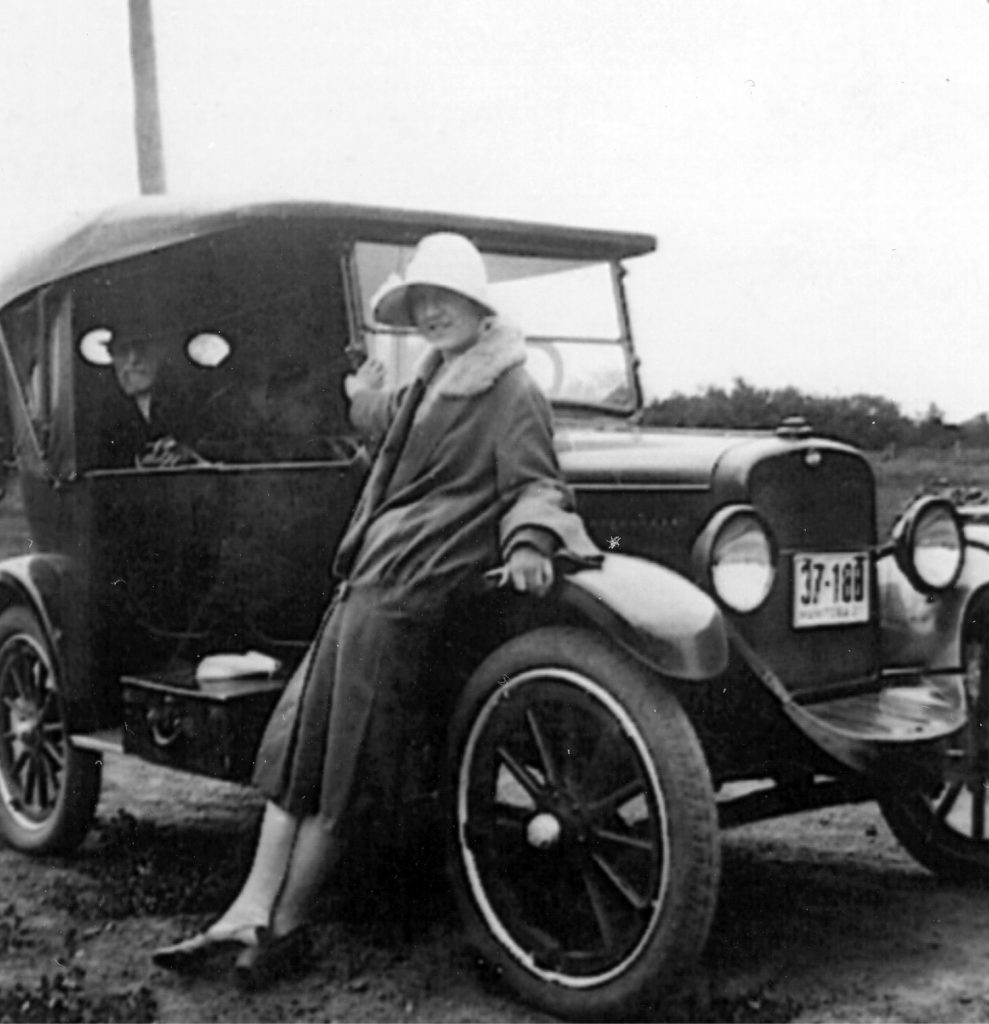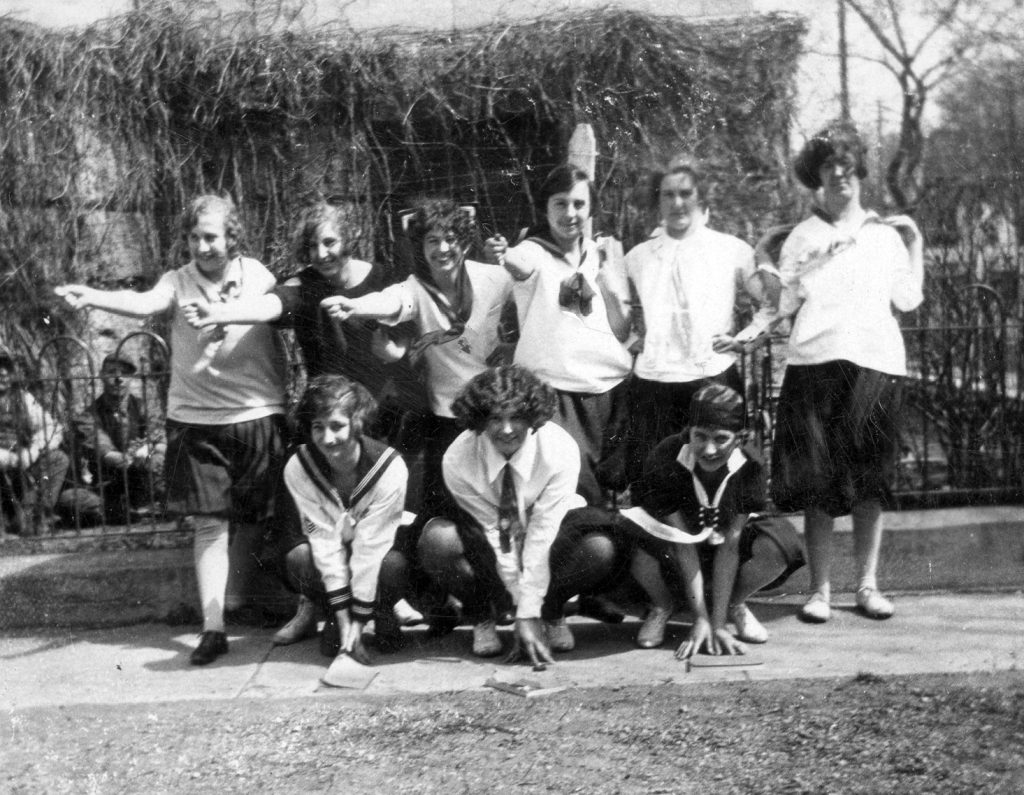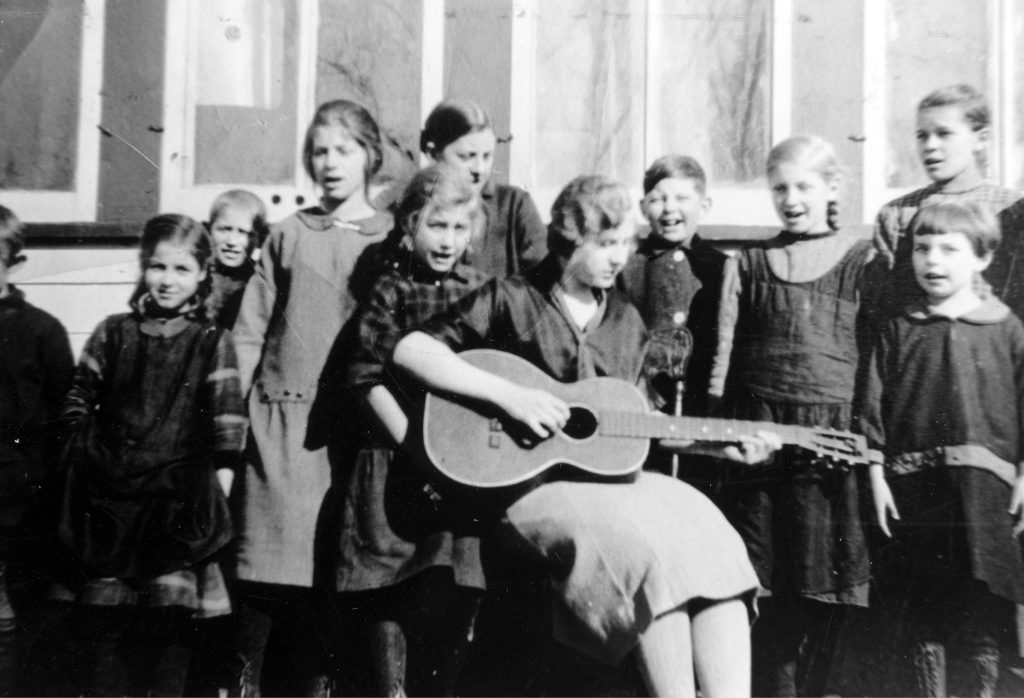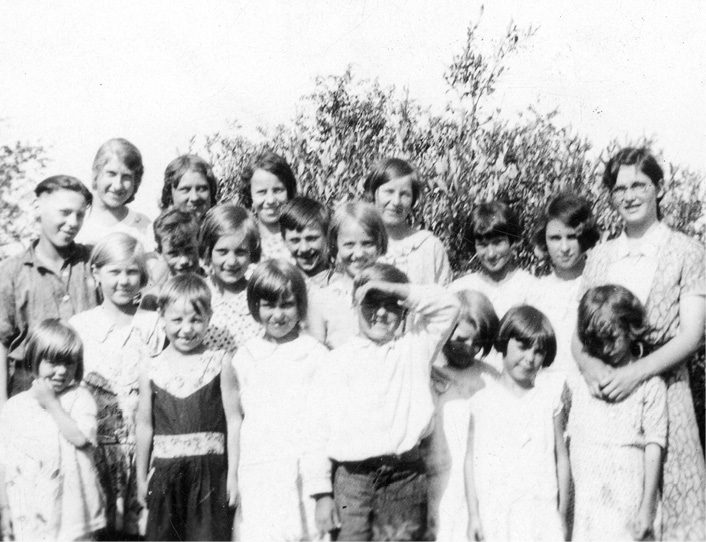Ida’s Memories of Teaching
Shirley Penner Bergen
My mother, Ida Hiebert (married name Penner), was one of the first women from Winkler to enter the teaching profession. She was born near Plum Coulee, Manitoba in 1903, as the youngest of Jacob and Maria Hiebert’s eleven children. Although she was fortunate to miss the heavy toil of the early pioneer days experienced by her older siblings, her diary and memoir provide a glimpse into the opportunities that education created for young Mennonite women.

Ida’s early school years were spent in the Bloomfield school division. She looked back on this time fondly, remembering how her grade two teacher taught her the names of all the wild flowers. In her diary, she described how the Christmas program was the highlight of the school year: “It was usually on the 23rd of December, the shortest day of winter, but it seemed the longest day for us. Finally, it was time to go. Two horses were hitched to the big bobsleigh and we all piled in for the two-mile ride to school. We small ones would have to get under the fur blanket, head and all, because it was so cold. But that did not keep us from hearing the sound of the bells jingling on the horses’ backs as they pulled the sleigh across the crunchy snow. At last came the loud ‘ho-ho’ from the driver and the horses would stop. We were there. With wide eyes we beheld our school, all lit up with a shining Christmas tree and walls and windows decorated so that we could hardly recognize our school. The rows of desks were pushed to one side and in their place were long benches on which our parents sat and listened to our plays and songs.”
After finishing grade eight, Ida stayed home, like her sisters, and learned to cook, sew, knit, and crochet. Likely, she would also have married by the age of twenty, but her father retired, sold the farm, and moved to Winkler where a high school had just been started. She was the right age to enter this school, which was run by J.R. Wolkof. Unfortunately, as she was set to start in 1918, a flu epidemic broke out and classes were cancelled. To make up for lost time, she took grades nine and ten in one year.
Afterward, Ida entered the Manitou Normal School, which trained teachers. As she recalled, “In 1921 I sent in my application to take four months of Normal School training in Manitou. The requirements were grade eleven and eighteen years of age. I had just graduated and turned eighteen in October so I was accepted. I had never lived away from home before. It was a memorable day for me when I packed my new trunk and set out for Manitou. Sarah Enns and I from Winkler and Mary Bryson from Darlingford found the same boarding place for $35.00 a month with an older couple. They had another boarder, a working man. Between the six of us we finished a big barrel of sauerkraut that winter. . . .
“We had a very good principal at Normal, Mr. J.W. Gordon. His way was to ask for volunteers to teach a class. This was a disadvantage to me because there were always others eager to do it so I could get out of it. The result was that at the end of the four months, I and seven others had to stay seven more weeks because he had not found out whether we could teach. I could not even go home between sessions. I cried bitterly that night, gritted my teeth and stayed. But in those seven weeks I learned more than in the previous four months. Mr. Gordon was like a father to me and gave me confidence. ‘You CAN do it,’ he told me over and over again. I began to believe that maybe I could. My blackboard writing improved. The Geography Lesson I had to teach in the public school was very well done, he said. I left with my Third-Class Teachers Certificate. To get my Second-Class Certificate I attended three Summer Schools graduating in 1927. Normal School had been transferred to Winnipeg so I never again entered the halls of that stately building where the direction for my life had been set.”

It is amazing that this teaching program could prepare young people to teach eight grades in four months. Imagine how much work it would be in a one-room school with eight grades, especially preparing handouts for the students. At that time, the teachers had to duplicate them on a home-made hectograph. Ida recorded the following memories of her early teaching days: “The following year I was hired to teach in a small country school five miles south of home, the village of Blumstein. This doesn’t seem far now but in those days the gravel roads were rough at best and a mire when it rained. My father let me use his new Touring Car when the weather was favorable. In winter I boarded close to the school for $14.00 a month. My father picked me up on Friday and brought me back on Monday. The cars had no anti-freeze so the water had to be drained every night after the first frost. I vividly recall him pouring water into the radiator early Monday mornings in sub-zero weather disregarding the water trickling down his sleeve. During the coldest winter months one of my brothers or sisters would pick me up with the horse and sleigh, unless there was a severe snowstorm. The weeks got very long if I had to stay at my boarding place for the weekend. I loved seeing my nieces and nephews and meeting my friends in church.
“On my first day as a teacher I tried to carry out what I had learned. Planning was one of my strong points. I got there early and put my plan on the side of the blackboard in great detail, showing how I was going to fill the minutes between 9 and 4 o’clock. Finally, I was ready. 9:00 came and went. No children arrived. I looked out the window to the east, then to the west… The prairie road led to some farm houses, but no children could I see coming. My timetable remained on the board. I went home.
“The next day — still no pupils. I stayed at school from nine to four and again went home. The third day two families came. The Public Health Nurse also came. When she saw their school sores, [impetigo] she quarantined them. So Monday my first five [students] stayed home with their sores, but five new ones came. During these days I was very happy that the Wolkofs lived across the road so I could go there with my problems. Finally, I had 15-20 pupils that first year.
“The school was a one-room wooden building with three windows on each side and a round iron stove in the middle of the room. Every day after the children were dismissed the room had to be tidied and swept, not by the janitor, but by the teacher. Keeping the stove going was one of the most difficult parts of my job. The coal bin was a large box on the side of the school with a large cover on hinges. Every day before leaving, I would have to lift the wooden lid, climb over the 4-ft high side, fill my coal pail and then get out without spilling it. The fire would not go out at night if I dumped in a pail of coal and closed all the drafts. In the morning I would come early, crawl into the bin again, and heat up the room before the children arrived. No such thing as turning up the thermostat!
“I enjoyed teaching children and influencing their lives. Wherever possible I got them to participate actively. Learning to perform for the class was important throughout the year but especially at the School Christmas Concert. I tried to arrange for every child to have a part. The entire community came to watch the concert, even if it was three hours long. The children all received candy bags which I packed the night before.
“I taught nature study as I had learned it, showing the children how to identify birds and wild flowers which were abundant everywhere. We were allowed to pick them to make wreaths for May Day or Children’s Day in church. In 1928 Nature Study Workbooks were prepared for Manitoba schools. These helped pass on a greater appreciation for the world around us.
“Music was a vital part of my teaching. When the older boys got fidgety while I was trying to teach them to sing from notes, I picked up my guitar and we had a singsong. Often I met with teenage girls in the evening to sing for fun. In Schönwiese the community formed an orchestra. In every school district a Young People’s Club was started from these musical get-togethers. We sang, recited poems, talked about God and the meaning of life. One of the songs we liked to sing was ‘Paddle Your Own Canoe‘:
‘If called to study or to play/ whate’er thy hands may find to do/ Accept the help that others bring/ but paddle your own canoe.‘
Chorus: ‘Just paddle your own canoe/ Just paddle your own canoe/ Success in the end will surely attend/ Just paddle your own canoe.
‘The greatest thing in life to know/ Is do the right in what you do/ And this is mostly done by those/ Who paddle their own canoe.
‘See those in life who’ve made a mark/ Whose noble deeds the world can view/ Their life should lead you in the way/ To paddle your own canoe’

“I did not have too many problems disciplining the children. I hated spanking which was the accepted form of punishment. My methods included writing sentences, begging pardon or making the person stand at his/her seat. But these methods didn’t always work. One dismally cold January day I had to punish four boys more severely. I made them each chop wood for five minutes. Then they had to think of a game to play with the others because it was too cold to go out for recess. In the evening a letter from Isaac, my fiancé, made for a good ending to a very difficult day. Before I got married in 1934 I taught in the Blumstein, Schönwiese, Edward, and Valleyfield school districts. In all my years of country school teaching there was one thing I could not accomplish. I never managed to read many of the tempting story books that lined the shelves of these schools. The reason was that I had to prepare lessons every night for all seven grades.
“My love for books created tension between me and my parents. Although my mother also had a desire to read, work always came first. The Saturday chores waiting for me when I came home for weekends were washing the floors, baking, sewing or helping in my older siblings’ homes. I sang in the church choir and taught Sunday School as well. Not much time for reading but I always tried to squeeze it in. We came to blows over the following incident.
“I hadn’t been teaching long when a World Book salesman came to visit me at my school. It didn’t take him long to convince me what a valuable asset these books would be for my teaching. So I bought them on the installment plan since I only made $80.00 a month. When I told my father about these good books, he was very disgusted. He had generously allowed me to keep all my wages which was very unusual in the 1920s. Also, he had planned to buy me a good horse when I turned 21 or got married, just as he had done for his other daughters. He was furious that I had squandered my money on a set of encyclopedias! So I made a deal. If I could keep the books, he didn’t have to buy me a horse. It seemed a bitter trade-off at the time, but looking back, it was a wise choice. Horses were replaced by cars shortly thereafter. My encyclopedias were useful, not only during my teaching days, but my own children had this resource as well. Encyclopedias were not readily available in school in the 1940s.”
From 1930–1932, Ida took time out from teaching to attend Winkler Bible School. This school was in German and the teachers were well-trained in the Bible and composition. This was good for students who only had grade eight, but Ida had been teaching so she was active in writing short plays, playing and singing and teaching Sunday School, preparing her own lessons. She was thrilled when the principal, said, “Your trial sermon is as good as any man’s.” As the school closed at the end of April, many young people were willing to try high school. J.R. Wolkof made this possible for them by reviewing the year’s work in May and June. With a high school diploma, new horizons opened for them and many became teachers, nurses, preachers, and pursued other occupations.
Her diary of 1933 changes in tone somewhat. Marriage was on her mind, although she rarely mentions her suitor directly as that was not her style. She believed that personal matters and angry thoughts should be kept private. She was always cheerful and pleasant even when she felt differently inside. This is what she found when she arrived at school 1 January 1933: “The school was warm when I got there, which was quite an improvement. But many traces of Christmas were left which we cleaned up. Only 15 of 35 pupils were present. I opened with the Lord’s Prayer, a chorus, a story and a talk of a few words and we wished each other a Happy New Year. During the first recess the children began tearing around the room, but calmed down one by one, when they had to forfeit something for being noisy. Since I had not prepared lessons and the classes were not all represented, I took the classes as was suitable, ending with a Bible story. I left the school at 5:00 p.m., corrected homework, had supper, prepared lessons for [the] next day and wrote two letters. I could have worked faster if my thoughts had not always wanted to stray.”
Ida married Isaac Penner in 1934. They planned to teach together in the Valleyfield School; however, Isaac did not receive his Teachers Certificate in the mail. Instead, they resigned from Valleyfield and Isaac became a truck driver. Ida spent the following seventeen years at home in Winkler where they raised a family of five, of which I am the oldest. In 1942 her parents needed more care, so Isaac and Ida moved into their home. Her mother had a debilitating stroke a few years later. It was a very difficult time. Ida’s mother passed away in 1946 and her father died in 1950. Isaac and Ida sold their house on Pembina Rd. and moved to Winnipeg where there were more opportunities for work for Isaac.
Eventually Ida resumed teaching. She taught for five years, and after a brief period of illness, substituted for seven more years. She noticed some differences between teaching in the 1930s and 1950s. For instance, she found teaching only one grade (instead of eight) to be very satisfying. Also, by the 1950s, the textbooks had greatly improved. She really appreciated the many aids now provided for the curriculum. Teacher handbooks had handouts to run off for each lesson, which lessened Ida’s work. Occasionally she used the hectograph for emergency handwork she prepared the night before, but there was now an improved version called a Duplicator in schools. Despite these improvements, the one thing that bothered her was the unruly behaviour of the kids in the classroom and hallways. She expected pupils to respect the teacher.

This is an example of one of the first women from Winkler who entered the teaching profession. These women were determined, dedicated, and creative; teaching opened a new sphere of activity for them. They did not do it for the pay nor was there tenure in those days. They were generally well accepted by the parents and improved the spiritual life in the villages through youth clubs. Most importantly, they gave the children a zest for learning. As Ida remembered, “I enjoyed teaching and becoming a part of the community. Lasting friendships were formed. We worked hard and enjoyed life.”
